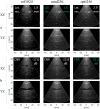Experimental 3-D Ultrasound Imaging with 2-D Sparse Arrays using Focused and Diverging Waves
- PMID: 29904182
- PMCID: PMC6002520
- DOI: 10.1038/s41598-018-27490-2
Experimental 3-D Ultrasound Imaging with 2-D Sparse Arrays using Focused and Diverging Waves
Abstract
Three dimensional ultrasound (3-D US) imaging methods based on 2-D array probes are increasingly investigated. However, the experimental test of new 3-D US approaches is contrasted by the need of controlling very large numbers of probe elements. Although this problem may be overcome by the use of 2-D sparse arrays, just a few experimental results have so far corroborated the validity of this approach. In this paper, we experimentally compare the performance of a fully wired 1024-element (32 × 32) array, assumed as reference, to that of a 256-element random and of an "optimized" 2-D sparse array, in both focused and compounded diverging wave (DW) transmission modes. The experimental results in 3-D focused mode show that the resolution and contrast produced by the optimized sparse array are close to those of the full array while using 25% of elements. Furthermore, the experimental results in 3-D DW mode and 3-D focused mode are also compared for the first time and they show that both the contrast and the resolution performance are higher when using the 3-D DW at volume rates up to 90/second which represent a 36x speed up factor compared to the focused mode.
Conflict of interest statement
The authors declare no competing interests.
Figures






References
Publication types
LinkOut - more resources
Full Text Sources
Other Literature Sources

